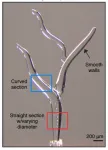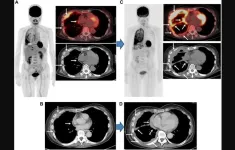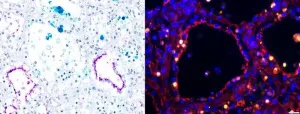(Press-News.org) A network of proteins found in the central nervous system could be harnessed to increase the effectiveness and reduce the side effects of popular diabetes and weight-loss drugs, according to new research from the University of Michigan.
The study, appearing today in the Journal of Clinical Investigation, focused on two proteins called melanocortin 3 and melanocortin 4 found primarily on the surface of neurons in the brain that play a central role in regulating feeding behavior and maintaining the body's energy balance.
Melanocortin 3 and melanocortin 4 impact everything from sensing long-term energy stores to processing signals from the gut regarding short-term fullness, or satiety, said U-M physiologist Roger Cone, who led the study.
The class of drugs known as GLP-1 agonists, which includes semaglutides (e.g., Ozempic) and tirzepatides (e.g., Mounjaro), have received substantial attention recently for their effectiveness in treating not only type 2 diabetes, but also obesity, heart disease and potentially addiction. They work by mimicking a natural hormone that the gut produces when it is full, triggering the brain to reduce feeding behavior.
"So the obvious question for us was: How do these GLP-1 drugs, which work by manipulating satiety signals, function when we prime the melanocortin system?" said Cone, professor of molecular and integrative physiology at the U-M Medical School and director of the U-M Life Sciences Institute where his lab is located.
Working in mouse models, Cone and his colleagues tested the effects of several hormones that reduce food intake. They compared the results in normal mice with mice that genetically lacked the MC3R protein, in mice that were given chemicals to block the activity of MC3R, and in mice that were given a drug to increase the activity of MC4R. (Because MC3R is a natural negative regulator of MC4R, meaning it decreases the activity of MC4R, blocking MC3R and increasing MC4R activity has similar effects.)
In all cases, Naima Dahir, first author of the study and a postdoctoral research fellow in Cone's lab, and colleagues found that adjusting the melanocortin system—either by inhibiting MC3R or increasing MC4R activity—made the mice more sensitive to GLP-1 drugs and other hormones that affect feeding behavior. The mice that were given a GLP-1 drug in combination with an MC4R agonist or MC3R antagonist showed up to five times more weight loss and reduced feeding than mice receiving only the GLP-1 drugs.
"We found that activating the central melanocortin system hypersensitizes animals to the effects of not just GLP-1s, but to every anti-feeding hormone we tested," Cone said.
The researchers also measured activity in parts of the brain thought to trigger nausea in response to GLP-1 drugs and observed no increased activation when GLP-1 drugs were combined with alterations to the melanocortin system. In contrast, priming of the melanocortin neurons significantly increased GLP-1 drug activation of neurons in hypothalamic feeding centers in the brain.
The findings indicate that pairing the existing GLP-1 drugs with an MC4R agonist could increase sensitivity to the desired effects of the drugs by up to fivefold, without increasing unwanted side effects. Ultimately, this approach could enable patients who are sensitive to the side effects to take a lower dose, or could improve the results in patients who have not responded to the existing drug dosages. Further drug development and clinical testing are needed before this can occur.
While this research has been conducted only in mouse models, Cone is optimistic that the results will translate well to humans.
"The melanocortin system is highly conserved in humans," he said. "Everything we've observed in the mouse over the past decades studying these proteins has also been found in humans, so I suspect that these results would also be translatable to patients."
This research was funded by the National Institutes of Health and Courage Therapeutics.
Study authors are: Naima Dahir, Yijun Gui, Yanan Wu, Alix Rouault, Savannah Williams, Luis Gimenez, Stephen Joy, Anna K. Mapp and Roger Cone, University of Michigan; Patrick Sweeney, University of Illinois; and Tomi Sawyer, Courage Therapeutics.
Study: Subthreshold activation of the melanocortin system causes generalized sensitization to anorectic agents in mice (DOI: 10.1172/JCI178250)
Written by Emily Kagey, U-M Life Sciences Institute
Disclosure: The University of Michigan has filed patents on MC4R agonist compounds related to this work. Roger Cone, Naima Dahir, Patrick Sweeney and Tomi Sawyer are named as co-inventors. Cone is a founder of Courage Therapeutics, a melanocortin receptor drug discovery company; Patrick Sweeney, Savannah Williams and Tomi Sawyer are shareholders in Courage Therapeutics.
END
New research demonstrates potential for increasing effectiveness of popular diabetes, weight-loss drugs
2024-07-15
ELSE PRESS RELEASES FROM THIS DATE:
Understanding the 3D ice-printing process to create micro-scale structures
2024-07-15
Advances in 3D printing have enabled many applications across a variety of disciplines, including medicine, manufacturing, and energy. A range of different materials can be used to print both simple foundations and fine details, allowing for the creation of structures with tailored geometries.
However, creating structures with micro-scale, precise internal voids and channels still poses challenges. Scaffolds used in tissue engineering, for example, must contain a three-dimensional complex network of conduits that mimic the human vasculature. With traditional additive manufacturing, where the material is deposited layer ...
Children’s Hospital of Philadelphia researchers develop antioxidant strategy to address mitochondrial dysfunction caused by SARS-CoV-2 virus
2024-07-15
Philadelphia, July 15, 2024 – Building upon groundbreaking research demonstrating how the SARS-CoV-2 virus disrupts mitochondrial function in multiple organs, researchers from Children’s Hospital of Philadelphia (CHOP) demonstrated that mitochondrially-targeted antioxidants could reduce the effects of the virus while avoiding viral gene mutation resistance, a strategy that may be useful for treating other viruses. The preclinical findings were recently published in the journal Proceedings ...
How climate change is altering the Earth’s rotation
2024-07-15
Climate change is causing the ice masses in Greenland and Antarctica to melt. Water from the polar regions is flowing into the world’s oceans –and especially into the equatorial region. “This means that a shift in mass is taking place, and this is affecting the Earth’s rotation,” explains Benedikt Soja, Professor of Space Geodesy at the Department of Civil, Environmental and Geomatic Engineering at ETH Zurich.
“It’s like when a figure skater does a pirouette, first holding her arms close to her body and then stretching ...
Comparison of FDG-PET/CT and CT for treatment evaluation of patients with unresectable malignant pleural mesothelioma
2024-07-15
“FDG-PET is generally considered as a useful metabolic evaluation tool, while it is also thought to have an emerging role for assessment of systemic therapy response.”
BUFFALO, NY- July 15, 2024 – A new research paper was published in Oncotarget's Volume 15 on June 20, 2024, entitled, “Comparison of FDG-PET/CT and CT for evaluation of tumor response to nivolumab plus ipilimumab combination therapy and prognosis prediction in patients with unresectable malignant pleural mesothelioma.”
Malignant pleural mesothelioma (MPM) is an aggressive neoplasm and affected ...
New concept explains how tiny particles navigate water layers – with implications for marine conservation
2024-07-15
A new UBC study published recently in Proceedings of the National Academy of Science (PNAS) has unveiled insights into how microscopic organisms such as marine plankton move through water with different density layers.
Researchers Gwynn Elfring and Vaseem Shaik found that density layers, created by variations in temperature or salinity, influence the swimming direction and speed of tiny particles navigating a liquid.
Pushers and pullers
“There are two different types of microscopic swimmers – ...
New research shows a frictionless state can be achieved at macroscale
2024-07-15
UTICA, NY – The president of SUNY Polytechnic Institute (SUNY Poly), Dr. Winston “Wole” Soboyejo, and postdoctoral researcher, Dr. Tabiri Kwayie Asumadu, have published a revolutionary new paper titled, "Robust Macroscale Superlubricity on Carbon-Coated Metallic Surfaces." This paper explores an innovative approach to reducing friction on metallic surfaces – a significant advancement that could have major real-world impacts.
The study shows that superlubricity – a state with virtually no friction that was once believed to only be achievable at nanoscale – can now be maintained at macroscale for extended time ...
A novel and unique neural signature for depression revealed
2024-07-15
HOUSTON - (July 15, 2024) - As parents, teachers and pet owners can attest, rewards play a huge role in shaping behaviors in humans and animals. Rewards – whether as edible treats, gifts, words of appreciation or praise, fame or monetary benefits – act as positive reinforcement for the associated behavior. While this correlation between reward and future choice has been used as a well-established paradigm in neuroscience research for well over a century, not much is known about the neural process underlying it, namely how the brain encodes, ...
Academic psychiatry urged to collaborate with behavioral telehealth companies
2024-07-15
Waltham — July 15, 2024 — The strengths of academic psychiatry departments and the fast-growing private telehealth sector are complementary, according to a Perspective article published in Harvard Review of Psychiatry, part of the Lippincott portfolio from Wolters Kluwer. Justin A. Chen, MD, MPH, a psychiatrist at Weill Cornell Medicine in New York City, and colleagues reviewed literature on provision of outpatient mental health care in the United States. They concluded that academic psychiatry departments and telehealth companies could mutually benefit from strategic collaboration.
Academic medical centers struggle to ...
NASA’s Webb investigates eternal sunrises, sunsets on distant world
2024-07-15
Researchers using NASA’s James Webb Space Telescope have finally confirmed what models have previously predicted: An exoplanet has differences between its eternal morning and eternal evening atmosphere. WASP-39 b, a giant planet with a diameter 1.3 times greater than Jupiter, but similar mass to Saturn that orbits a star about 700 light-years away from Earth, is tidally locked to its parent star. This means it has a constant dayside and a constant nightside—one side of the planet is always exposed to its star, while the other is always shrouded in darkness.
Using Webb’s NIRSpec (Near-Infrared ...
Receptors make dairy cows a prime target for influenza, ISU team finds
2024-07-15
AMES, Iowa – As highly pathogenic avian influenza has spread in dairy herds across the U.S., the virus is being detected in raw milk. A new study by a broad team of researchers at Iowa State University’s College of Veterinary Medicine helps explain why.
Sialic acid, a sugar molecule found on the surface of some animal cells, acts as a receptor for influenza. Without sialic acid providing an entry point to attach, invade and infect, a flu virus is unlikely to find a potential host hospitable.
Before the recent HPAI outbreak ...




